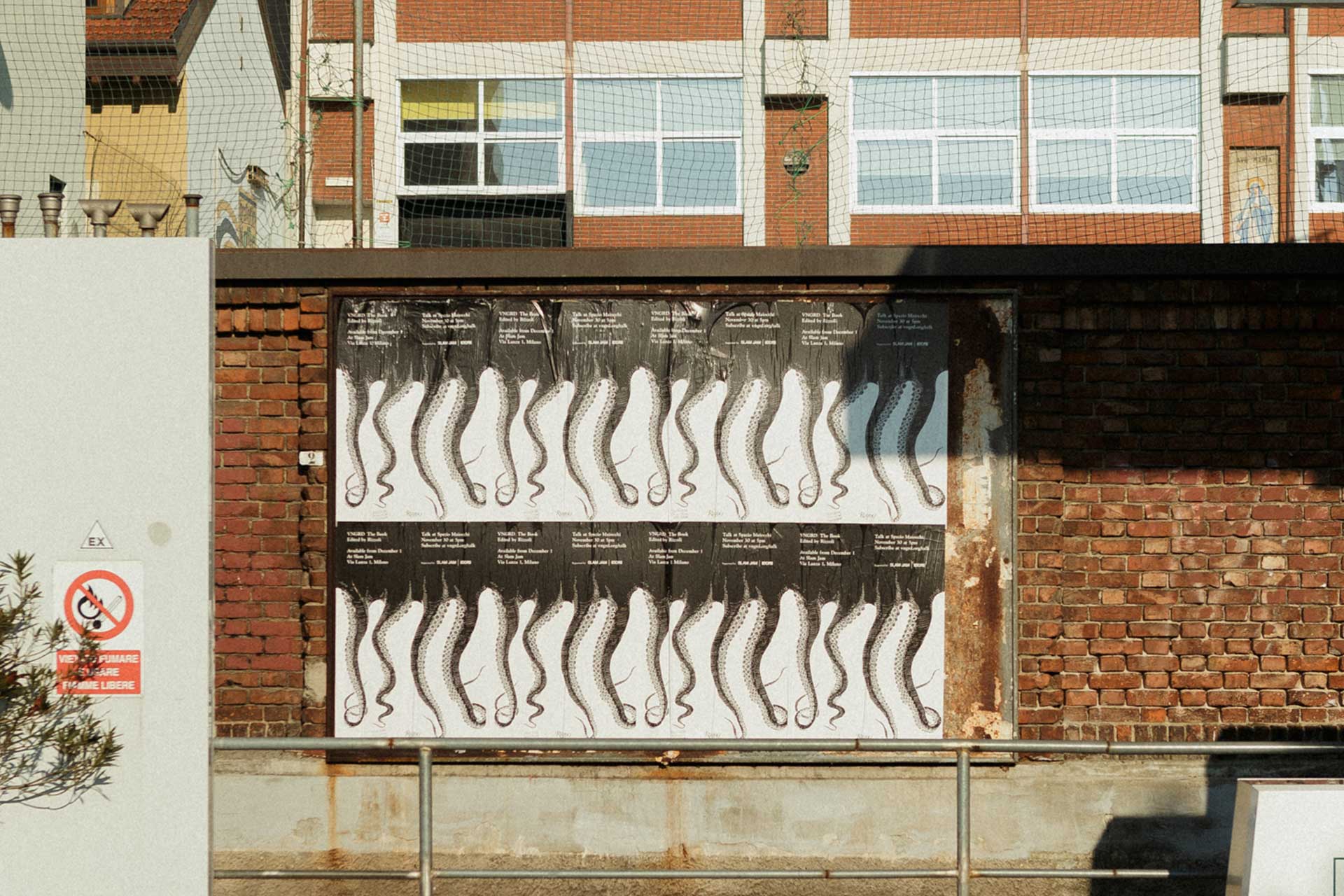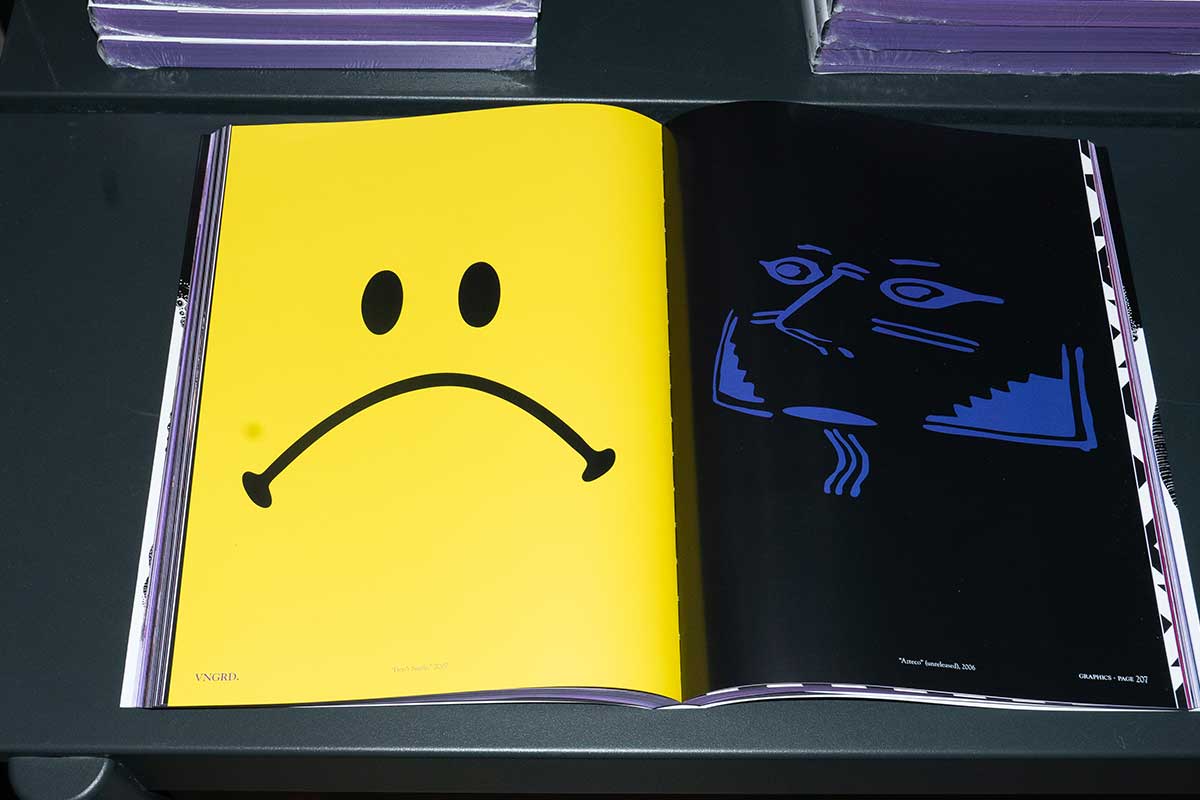The VNGRD publication reconnects the roots of streetwear with its entry into the Milanese and international fashion scene
VNGRD, the book
The book was born with the intent to retrace and bring to the surface the production and the essence of the brand VNGRD, founded in 2005 by Giorgio di Salvo and Paolo Budua. The label evolved from the collaboration of a series of creatives linked to Milanese and international underground culture. The need and importance of being able to bring the vision to a younger audience led to the evolution of a system that has placed a network of brands, recognized for the meaning of street style, more linked to the fashion system.
The collaborations included in the book, and fundamental in the period of development of VNGRD, are those with Virgil Abloh, creator of the brand, Off-White, and artistic director of the men’s collection at Louis Vuitton; Marcelo Burlon, head of the creative at the brand, Country of Milan; Erik Brunetti, artist and designer founder of the brand FUCT; and several others. No less relevant is the communicative reason behind the book. The minimal use of the web and other social media platforms in 2005 and subsequent years, did not allow for online storage of data, articles and information regarding VNGRD. Related to the release of the book is also the physical creation of a collection in collaboration with Slam Jam, another key player in the evolution of the brand. They worked on recreating, in an authentic way, the first pieces of Vanguard, two sweatshirts and t-shirts in the colors proposed in 2006 that bear the prints of the octopus. Conceived and designed by Giorgio Di Salvo, this graphic will then give life to the streetwear brand that carries the name, taking up the work started by VNGRD, which also assisted in the production of the book.
The importance of recreating the archive
As the VNGRD project came to a close, no work was catalogued and no information could be retrieved through an archive. For this reason, Budua, who edited the composition of the book, undertook to recover and request some of the garments of the time.
This was so as to have them available for the production of the book and to shoot the services that mainly comprise it. Budua states: «We were lucky to be able to get the samplers to survive even after years, about fifteen, but there is still plenty of VNGRD stuff around that we were able to re-shoot and use in editorials and many pages of the book practically came from that work». From a conceptual point of view, the founders continue, it was important because those who saw it today were able to relate with today’s gaze to things that came out fifteen years ago in a natural and current way as well.
This work allowed them to rediscover not only several things that happened within the brand, but also to physically position themselves in history and fix the certain moments and productions that occurred over the duration of the project. Also, part of the archive is composed of photographs, sketches, drawings and graphics that have been part of the passage of time within the brand and in general, of this collective that surrounded it.
Vanguard, the approach beside the brand
In addition to a brand, the founders define VNGRD as an attitude, an approach. Summarized in a final sentence at the end of the book: Whatever you do, we did it first. «What is VNGRD still today? A book, a spirit, but also an approach, a kind of method applicable to anything you can do. The approach in this case is definitely radical and radicality has a certain value», states Budua. In this sense, the founders both speak to the disruptive concept of practicing radicalism, which of course puts them ahead of others and gets them to certain situations first.
The research was based on doing something that hadn’t been done yet and that no one would expect, both in the choice of clothing and suppliers, in the choice of graphics and images, even in the communication through advertising. This approach is the same one that caused the brand to move away from anything that could become mainstream, to the one with the octopus graphic. The moment the graphic started becoming successful and popular, Di Salvo, who designed it, and Budua decided to step away from the project. The possibility of success and popularity of this graphic was later demonstrated by the creation of the Octopus brand with its own distinctive feature.
This approach has also favored the formation around the brand of a streetwear culture able to involve vertically, and through collaborations, different actors, making external contributions essential. For the same reason, these various external contributors were integrated into the book through direct testimony related to the historical content and not the brand itself.
The Octopus and the capsule collection
The VNGRD brand continues to be recognized by its audience and has a particular philosophy that surrounds it. Due to this, it juggles between periods of stasis and hibernation, with periods of flare-ups, like this one with the release of the book, but also a collection in collaboration with Slam Jam, explains Budua. The octopus print is the protagonist of the collection. At its origin, there is the collision of Di Salvo’s passion for graphics and the world of clothing, starting from the first collection in which the concept of a t-shirt needed to be evolved because it was a basic garment. Each graphic had meaning related to the world of graffiti, or minimalist according to the references of the brand. With the same approach, they played with the graphics on the neck or that passed from one side to the other of the garment. Beyond these limits, born was the graphics of the octopus, close to the inspiration of the designer’s animals. The tentacles could play with the sleeves while the hood became part of the octopus’ body. This garment was the most recognizable and successful in sales. It is still relevant because the brand manages to survive through this graphic.
The cover of the VNGRD book does not have a title, but only the tentacle graphic. Thanks also to Octopus who financed the production of the book, it was decided to reproduce the first three items, with this graphics, that were made in an accurate way, explains the founders. Slam Jam, who took part in this production, had already supported the production of VNGRD in 2006 and was close to their reality. «On a technical level, the octopus graphic is difficult and expensive on an industrial level to be reproduced because in order to have a perfect print originally the whole hood was screen printed with the color that then went on the sweatshirt. When Octopus created the brand, this way of producing the model was abandoned because of its high costs; now the collection proposes for the first time the reproduced print as in 2006/2007», explains Budua.
Di Salvo adds: «Given the commercial and industrial evolution that the sweatshirt and the garment itself have had, the desire to reproduce the original also derived from wanting to show how it was originally imagined and created, making it possible to understand the manufacture, the weight, the natural details».
Lampoon reporting: at the root of streetwear
The work of VNGRD is defined by diverse people, who are active in the field, as a predecessor of several elements, graphics and patterns that have become common in recent years through the commercialization and mainstreaming of street style and streetwear. Few in those years approached this world, looking at it almost with contempt. Years later there were collaborations through friendship ties, with Costume National for example. On the contrary, they were taking cues from elements close to the underground of some brands such as Moschino or Japanese brands, closer for the aesthetic.
On a technical level, however, the two worlds were already quite close, considering that VNGRD, for example, relied on some of its production by printers who did their screen printing and also did the printing for Dolce & Gabbana. Everything mentioned about that relationship is known to be quite different in this historical period. There are continuous collaborations between established brands in fashion and others from streetwear, as already mentioned in the above collaboration between Virgil Abloh and Louis Vuitton. The purpose of the publication was not nostalgic or celebratory, explain the founders, but to create a document that could also have a sharing and research purpose. This explains a number of dynamics and events that happened that might still be of interest today in the apparel, design and graphic fields.
The release of this book becomes a fundamental element to historicize and fix a historical period of great ferment in the city of Milan, able to bring together under different cultural aspects a series of visionaries in the underground scene. At the time, Milan lacked a common energy, explains the VNGRD founders, between what was born at the bottom and the more classic fashion. The two environments were quite separate and often connections were sought abroad. It seems clear, both from the external contributions and from the backward analysis of the phenomenon, that that period led to a series of connections, realities and relationships between people that resulted in the construction of an industrial network of global fashion related to streetwear successful today.
VNGRD
book produced by Paolo Budua and Giorgio Di Salvo in collaboration with IUTER and published by Rizzoli New York the first of December 2021. Born with the aim of telling the story of the brand VNGRD and the trends that have been anticipated with respect to the evolution of street style, streetwear and graphics.




















